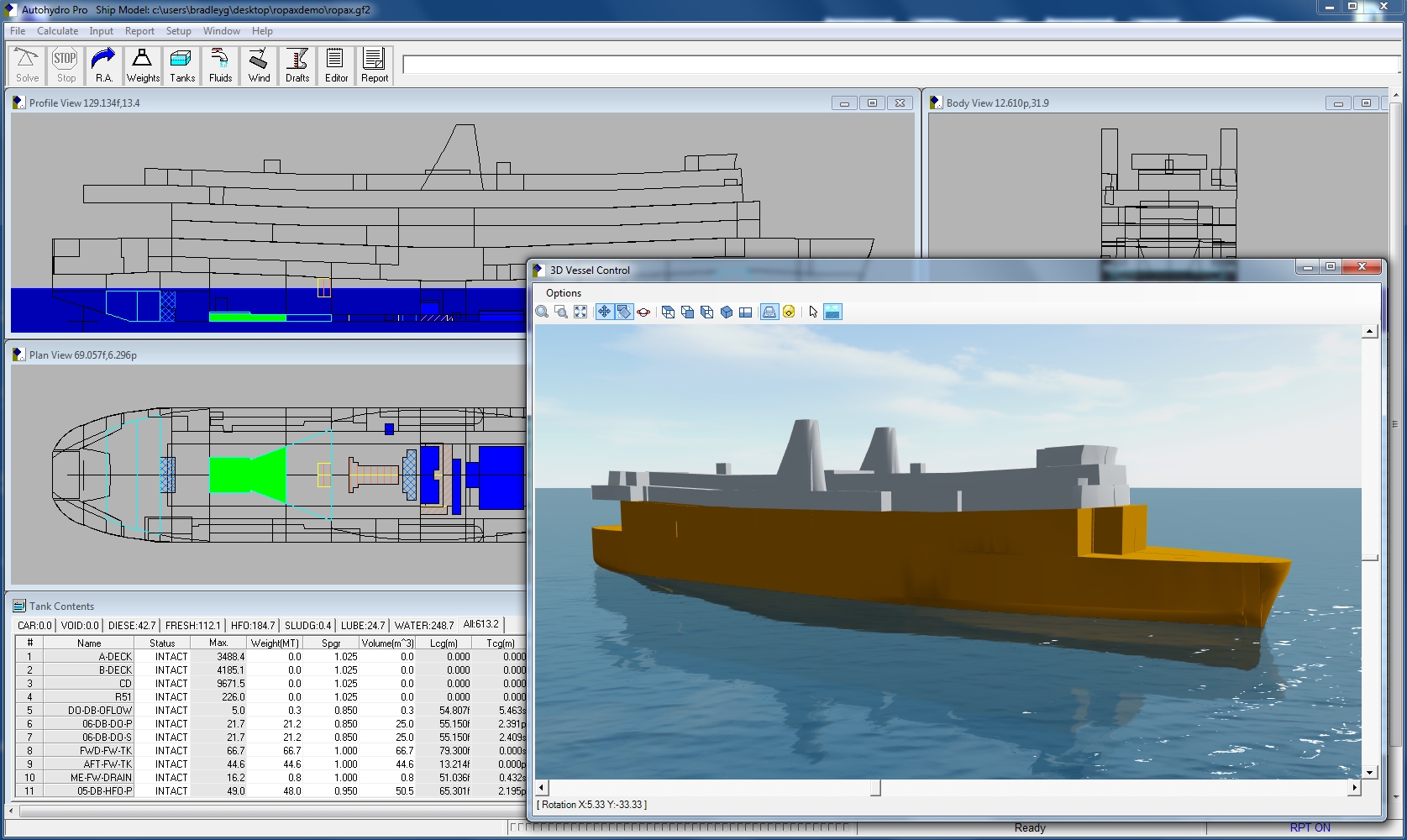Autohydro Hydrostatics & Stability
Autohydro is the state-of-the-art hydrostatics and stability program. It performs intact and damaged analyses and produces customizable stability reports which are accepted by all major approval bodies.
Autohydro is a complete hydrostatics and stability calculations program for naval architects, ship designers and marine engineers. A true ‘floating simulator’, Autohydro reports the reaction of the model to various conditions such as a loading configuration, a damage situation, conditions involving outside forces, wind or high speed turning momentum or some combination of these. Autohydro can also be used to obtain hull form characteristics and capacities. Vessel attitude is displayed graphically and in text on the screen. Report information, text and graphs, can be shown on the screen, printed, saved or exported to other Windows applications.
Vessel Model – Entire vessel models may be generated in Autohydro or the user can import hull shapes from Autoship and then add geometry such as tanks, compartments and superstructure. Vessel models are defined by transverse sections, which can be entered by typing in offsets, or by creating a combination of primitive shapes such as cones, boxes or surfaces of rotation. These objects can then be fit or joined to each other to quickly make a complex model. Contents, effectiveness, specific gravity and sounding tubes are assigned to each tank. Margin lines and deck edges can also be defined.
Interactive & Run File Modes – The user has 3 methods for performing calculations. The pull down menu system and on-screen selection and setting can be used for most loading condition set-ups and simple calculations. Individual commands can be typed in for more complex calculations or the run file editor can be used to organize many commands for lengthy calculations and to generate in-depth reports. The run file editor has a built-in error checker to verify all commands. Users can develop a library of run files for future use and modification. Command macros, with looping capabilities, may also be defined, run and stored.
Windows® – Autohydro operates under Windows and provides a graphic, intuitive interface. The main screen shows Profile, Plan and Body View plus a full report of current vessel attitude including Draft, VCG and GM with FSM.
Conditions – Autohydro calculates using tanks, cargo spaces and compartments in intact, damaged, frozen or spilling conditions. Waves and wind velocity and direction may be specified. As well, Autohydro calculates for high speed turning and grounding situations.
Output – Full reports and graphs of loading, longitudinal strength, stability, righting arms and hull parameters can be produced, and saved or sent to the printer. As well, Autohydro can evaluate stability with regard to published stability criteria and a warning is issued if the limit is not met. A sounding/ullage correction table function allows you to adjust the output to correlate exactly with approved loading tables. The Condition Summary Report makes stability booklet preparation easy as specific conditions and parameters can be tabulated. Output from Autohydro has been accepted by all major governing bodies such as Lloyds, Det Norske Veritas, ABS, the U.S. Coast Guard and the Canadian Coast Guard.
Custom Reports – Reports can be formatted or modified off-line using either the built-in Report Editor or Microsoft Word® and Word® macros.
Operating System Requirements: Windows® 10 and 11 Professional (32 or 64 bit), .NET Framework 4.8 with a Pentium Processor. Minimum resolution: 1280 x 800 (WXGA). OpenGL: recommended v3.2 or higher, minimum v2.1.
|
||
Key Features
- Windows® 11 Compatible
- Extensive model building capabilities
- Display of current vessel attitude in three views
- User-configurable floating parameters shown on-screen
- Probabilistic Damage assessment to handle new rules for cargo and passenger vessels
- Multi-window interactive user interface
- 3D viewer
- Pull-down menu, command line or batch file operation
- User-defined stability criteria, macros and menu structures
- Generation of reports with graphs
- Downflooding angle curves production (for protected, unprotected, and critical points)
- FSM definition that is able to meet specific Class requirements
- Draft mark report generation
- Res 14 (Estonia) function
- One hold damage for bulk carriers
- Corrected shear force at bulkheads function
- Automatic or manual wind area definition
- Visible length, propeller immersion and air draft functions
- MARPOL Regulation 23 – Accidental oil outflow performance
- MARPOL Regulation 12A – Oil Fuel tank protection
- Second method added for intermediate steps
- Enhanced report to create large documents (PDF files only)
- Dynamic limit definition
Automatic Report Generation Features:
- Hydrostatics, cross curves and righting arms
- Longitudinal strength calculations
- Floodable length calculations
- Tank capacities, sounding/ullage tables
- IMO probabilistic damage calculations
- Resolution 14 damage calculations
- Sounding/ullage correction table
- Condition summary eport
Pro Version
- Unlimited Intact Stabilty
- Unlimited Damage Stability
- Longitudinal Strength Calculations
- IMO Subdivision Index for both Cargo & Passenger Vessels
Standard Version
- Intact Stability up to 25 Tanks

